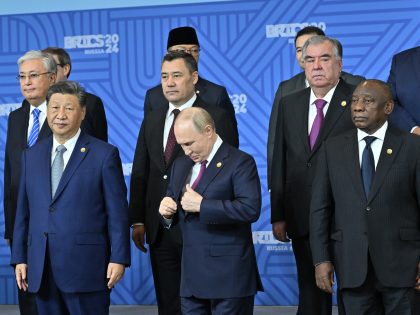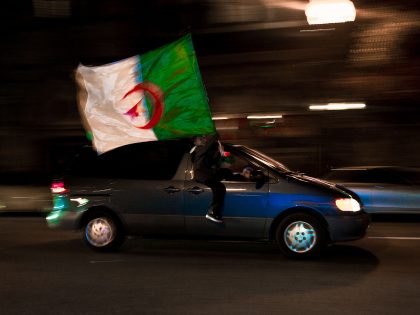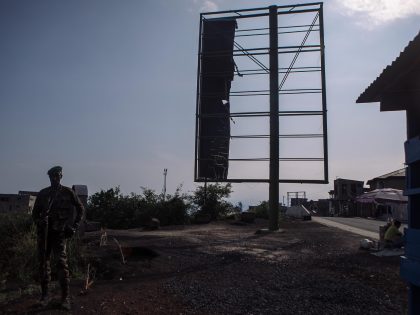Profits and bleeding hearts
We speak to an aid worker and trade unionist at the forefront of campaigns to halt the transnational corporate education reform movement.

Mark Zuckerberg in 2008.
Microsoft’s Bill Gates and Facebook founder and CEO, Mark Zuckerberg, who both double as billionaire philanthropists, have had their eyes on African schools for a while.
“We live in a world where talent is evenly distributed, but opportunity is not,” Zuckerberg wrote on his timeline a month or two ago. And the “gap between talent and opportunity,” he noted, “is among the greatest in Africa.” Around the same time, Gates expressed similar sentiments in a message to a UN conference on science, technology and innovation, declaring that, in order to solve poverty, “it’s important that we invest in the bright minds and bold ideas that can deliver the next generation of solutions to people, everywhere.”
Around the same time, the CEO of The Gates Foundation offered a mea-culpa of some sort for getting it wrong on education reform in the US. But it hasn’t resulted in any hubris when it comes to Africa. Gates and Zuckerberg are major investors in Bridge International Academies, an American education corporation, which targets the world’s “700 million families who live on less than $2 USD per day” with, what they call the “highest-quality education products.” So far, Bridge (who tweet here) are serving around 100,000 students in Uganda, Kenya and Nigeria, and are hoping to expand to Liberia as well as to some 4,000 schools in the state of Andhra Pradesh in India in the near future.
Bridge has made the headlines – mostly not favorable – a few times this year. First, in March, the Liberian government announced it may entrust its entire primary education to the company. As widely reported at the time, Liberia’s interest in Bridge didn’t go down well with the UN’s Special Rapporteur on the Right to Education, Kishore Singh, who called it “ironic that Liberia does not have resources to meet its core obligations to provide a free primary education to every child, but [can] find huge sum to subcontract a private company to do so on its behalf.” To Singh, (and others) the move symbolizes the extent to which “public schools and their teachers, and the concept of education as a public good are under attack.”
Then last May, Bridge had a Canadian education researcher, Curtis Riep, (a PhD student who focuses on for-profit education), arrested in Kampala, Uganda. Bridge it turned out was anxious about Riep’s less than flattering findings on the quality of its schools there. Bridge even published a wanted ad for Riep in a Ugandan newspaper a few days before the arrest.
The accusations that Bridge leveled at Riep – which came to nought during the investigation – included criminal trespassing and impersonation. The incident put Bridge back into the news.
Driven by the desire to expand its operations and profit, and desperate to avoid any negative press, Bridge’s campaign to intimidate and discredit Riep isn’t surprising. And as Bridge has admitted, the deal with Liberia depended, in part, on how well things were going in Uganda and Kenya. Criticism, then, can be costly.
But Riep isn’t the only one to challenge Bridge’s “win-win” narrative. He’s part of a growing coalition of human rights professionals, who seek to halt the transnational corporate education reform movement. Education International (EI), the world’s largest federation of teachers unions, and ActionAid International, an international development organization with its secretariat based in Johannesburg, South Africa are at the forefront of this push back. To Angelo Gavrielatos, who leads EI’s campaign against the commercialization of education, and Tanvir Muntasim, the international policy manager for education at ActionAid, Riep’s arrest illustrates the extents to which Bridge will go to safeguard its “market share” in Africa. I asked them to tell us a little bit more about Bridge’s business model.
Let’s begin with the basics: who is backing and investing in Bridge International Academies?
Tanvir Muntasim (TM): Bridge has been in Kenya since 2009 and gets it funding from a curious mix of investors, including the International Finance Corporation (IFC), the World Bank’s private sector investment wing and bilaterals like the United Kingdom’s Department for International Development (DfID). Bill Gates, Mark Zuckerberg and Pierre Omidyar are major investors as well. In 2014, the IFC invested US$10 million in Bridge in Kenya. This is in stark contrast to the fact that at the same time, the Kenyan government received no funding to enhance the provision of education. Combined with Pearson [the biggest education company in the world], Bill Gates, Mark Zuckerberg and Pierre Omidyar, Bridge has received over US$100 million in recent years. A for-profit organization like Bridge receiving development aid is questionable and doesn’t sit comfortably with human rights obligations, as recently seen in concerns expressed by both the UN Committee on the Rights of the Child (UNCRC) and UN Committee on Economic, Social and Cultural Rights (UNESCR).
Is it the external funding that makes them low-cost? What’s the business model here?
Angelo Gavrielatos (AG): They’re only low-cost in name. It’s part of the marketing spin associated with Bridge and the like. They like to create the impression that they’re catering for the poor, providing access to out-of -school children. There is nothing low-cost nor affordable about the fees they charge. The fees can be up to 40% or more of the daily income of the poorest. They present themselves as caring companies, philanthropists, concerned with education and children, but if this were true, they would work with the education community and teachers to strengthen public education, but they don’t. The business-model of such for-profit chains is built on driving down teachers’ costs and creating economies of scale through standardizing curriculum development and delivery. The largest single budget line in schools is teacher salaries. For-profit school chains maximize their profit by either employing fewer teachers, underqualified unlicensed teachers or unqualified staff paid at a fraction of qualified teachers. In the case of Bridge, it employs high school graduates who receive a few weeks of training. The curriculum used in these for-profit chains is standardized and scripted unqualified staff deliver lessons by literally reading word for word from a tablet. The material downloaded onto the tablets, instruct staff exactly what to say, what to do, what to teach, and how to teach it. Activities are pre-set and scripted including instructing teachers when to ‘Pause’ when to ‘Circulate for 30 seconds’ when to ‘Rub the board’ and when to tell pupils to ‘Close your textbooks.’
For-profit chains also cut down on costs, by teaching in spaces that are not fit for the purpose. There are examples of vacated, unused office spaces being used as schools. These spaces often lack the most basic materials needed for effective teaching and learning. In many instances, they don’t have playgrounds, nor libraries, nor other necessary school facilities.
The business model used by for-profit chains like Bridge is such that they seek to either exploit loopholes or neglect legislative requirements with respect to the adherence of minimum standards required for the provision of schooling. In Kenya, for example, it argues that it is an ‘informal’ school operation and therefore it should not have to comply with government regulations applicable to schools insofar as the employment of qualified staff and adherence to the national curriculum is concerned. When the government announced last year that it would require half of its staff to be qualified, Bridge actually protested, because it considered such a regulation an infringement on its business. So much for the right of every child to be taught by a qualified teacher delivering an engaging curriculum!
In Uganda, the authorities put a halt to the expansion of Bridge’s activities, because it failed to meet regulatory requirements applicable to schools. In a statement to Parliament last August, the Education Minister (and First Lady), Janet Kataha Museveni, announced the closure of Bridge International Academies for failing to operate in accordance with national requirements with respect to the provision of education. A technical inspection report had found that, among other things, “poor hygiene and sanitation [in these schools] put the life and safety of school children at risk”. The Uganda National Teachers Union welcomed the announcement and called on the Government to remain steadfast in demanding compliance to minimum education standards.
TM: Until last January, none of Bridge’s schools in Kenya were registered with the government. Kenya has now passed regulation on the alternative provision of basic education and training institutions (APBET) and Bridge is attempting to register its schools. But the decision of the Ugandan government to shut down Bridge schools there is affecting their acceptability. The Liberian government has also decided not to let BIA run all the schools in the pilot and has invited other education providers to participate in the pilot, so the monopoly, along with the volume of government funding that they expected and which could have let them cut down costs further isn’t likely going to happen.
How do Bridge and other corporate education reformers defend these practices? Is there any evidence of success?
TM: Just last year, the World Bank President Jim Yong Kim claimed that Bridge schools are producing better learning outcomes than public schools for only US$6 a month. In a statement that we issued with other organizations, we pointed out that there is no evidence that supports this claim, apart from biased data that Bridge has produced itself. In reality, the costs are much higher than $6 a month. In Kenya, for example, when you add the costs of meals, uniforms, exam fees and text books, one child’s education can cost as much as USD$16 to $20 a month. That’s nearly 70 per cent of the monthly income of many people. And even if it were only $6 a month, it would still interfere with the food security of people in the poorest neighborhoods. We have raised these concerns with the World Bank multiple times, but we have seen little effect in their funding practices thus far, apart from the fact that Mr Kim has stopped citing it as a good example.
AG: There is no evidence at all to support the claims of these companies that it improves the quality of education. At the same time, there is plenty of evidence that shows that if you apply market principles to the provision of education, you deepen inequality and segregation. And that is what is happening with these schools.
Children are the first losers in this story, because with any corporation, the interests of Bridge and others lie with satisfying their profit motives and/or their shareholders. In education, where the profit motive prevails, the first losers are students, their teachers and the communities they serve. After health, education is the last frontier for venture capitalists. Just think about it, education and children are the most sustainable resources in the world. They will always be there. We should be challenging those individuals and corporations pushing this grotesque commercialization and privatization of education, which reduces students to nothing more than an economic unit. They should be asked a couple of very simple questions. ‘Do you support the right of every child to be taught by a qualified teacher, an engaging curriculum in a safe environment that is fit for its purpose? Would you volunteer your own child to be taught by unqualified staff with a scripted curriculum in a vacant office building?’ If their actions are anything to go by, the answer to these questions would be ‘no’. If it’s not good enough for their own children, it’s not good enough for other people’s children.
What needs to happen or be done to get these corporations out of the education space? And what role do governments play in protecting children from such profiteering?
TM: Hundreds of human rights organizations and teachers unions are confronting governments with the fact that they are shirking their responsibility (of providing free, quality education), and urging the World Bank to stop investing in these companies, to stop basing their views on self-produced evaluations and to support public education systems instead. However, in Kenya we say that the World Bank has recently invested US$10 million in Bridge and none in public education. Even when Bridge resorted to the grossly unethical scare tactics to get an education researcher arrested and harassed in Uganda, we haven’t seen any formal reaction from the investors in Bridge. A few months ago, The UN Committee on the Rights of the Child said it was concerned that UK aid money was going to private education providers and called on the UK government to refrain from such financing. The UK government is being drawn into the dispute after investing £15 million in the venture fund, Novastar, to support the latter’s investment in Bridge International Academies. We believe that if good quality public education is provided, the demand for such private schools will fall. The question we often ask community members is ‘if you could choose between good quality free public education and good quality private education, where would you send your children?’ The answer, invariably, is good quality public education. So that’s what we are fighting for.
AG: Quite frankly, what could be a higher order priority for a government than the provision of quality education, noting how key it is to the educational well-being of its children and a nation’s future productivity and therefore prosperity? Governments must implement and enforce a legislative and financing framework that ensures the achievement of Sustainable Development Goal 4, (inclusive and equitable quality education and promote lifelong learning opportunities for all) and to protect and recognize the professional judgment of teachers and educators on questions of methodology, pedagogy, curriculum, assessment and reporting. Where non-state actors are involved in the provision of schooling, they must conform to minimum standards, follow national curricula, employ qualified teachers and use classrooms that are fit for the purpose. Companies must be required to adhere to strict financial regulations, including independent auditing and regulations to monitor how government funds are spent. And, where they are in receipt of any government funding, directly or non-directly, they must be not-for profit. The profit motive has no place in dictating what is taught, how it’s taught nor how our schools are organized.



















